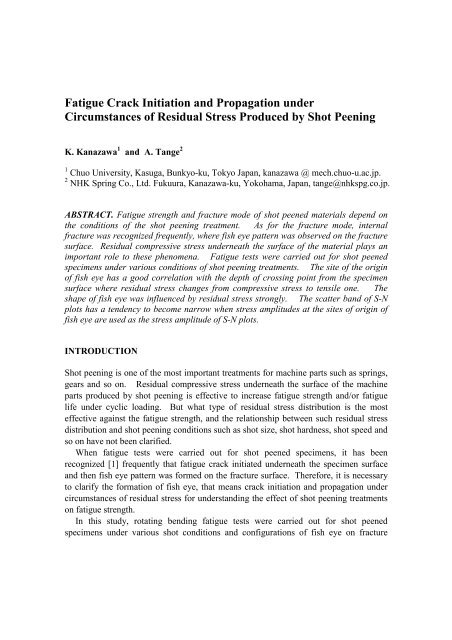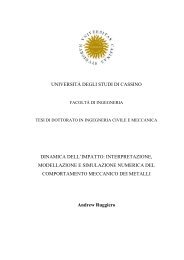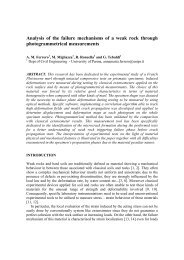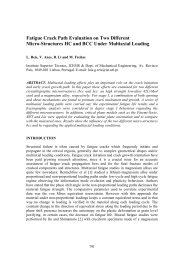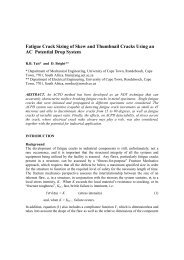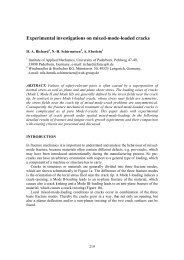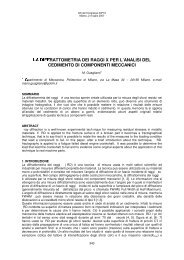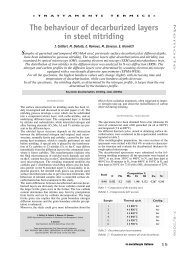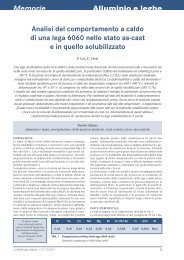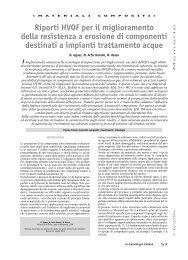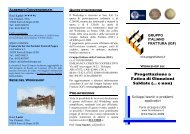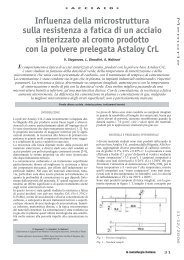Fatigue Crack Initiation and Propagation under Circumstances of ...
Fatigue Crack Initiation and Propagation under Circumstances of ...
Fatigue Crack Initiation and Propagation under Circumstances of ...
Create successful ePaper yourself
Turn your PDF publications into a flip-book with our unique Google optimized e-Paper software.
<strong>Fatigue</strong> <strong>Crack</strong> <strong>Initiation</strong> <strong>and</strong> <strong>Propagation</strong> <strong>under</strong><br />
<strong>Circumstances</strong> <strong>of</strong> Residual Stress Produced by Shot Peening<br />
K. Kanazawa 1 <strong>and</strong> A. Tange 2<br />
1 Chuo University, Kasuga, Bunkyo-ku, Tokyo Japan, kanazawa @ mech.chuo-u.ac.jp.<br />
2 NHK Spring Co., Ltd. Fukuura, Kanazawa-ku, Yokohama, Japan, tange@nhkspg.co.jp.<br />
ABSTRACT. <strong>Fatigue</strong> strength <strong>and</strong> fracture mode <strong>of</strong> shot peened materials depend on<br />
the conditions <strong>of</strong> the shot peening treatment. As for the fracture mode, internal<br />
fracture was recognized frequently, where fish eye pattern was observed on the fracture<br />
surface. Residual compressive stress <strong>under</strong>neath the surface <strong>of</strong> the material plays an<br />
important role to these phenomena. <strong>Fatigue</strong> tests were carried out for shot peened<br />
specimens <strong>under</strong> various conditions <strong>of</strong> shot peening treatments. The site <strong>of</strong> the origin<br />
<strong>of</strong> fish eye has a good correlation with the depth <strong>of</strong> crossing point from the specimen<br />
surface where residual stress changes from compressive stress to tensile one. The<br />
shape <strong>of</strong> fish eye was influenced by residual stress strongly. The scatter b<strong>and</strong> <strong>of</strong> S-N<br />
plots has a tendency to become narrow when stress amplitudes at the sites <strong>of</strong> origin <strong>of</strong><br />
fish eye are used as the stress amplitude <strong>of</strong> S-N plots.<br />
INTRODUCTION<br />
Shot peening is one <strong>of</strong> the most important treatments for machine parts such as springs,<br />
gears <strong>and</strong> so on. Residual compressive stress <strong>under</strong>neath the surface <strong>of</strong> the machine<br />
parts produced by shot peening is effective to increase fatigue strength <strong>and</strong>/or fatigue<br />
life <strong>under</strong> cyclic loading. But what type <strong>of</strong> residual stress distribution is the most<br />
effective against the fatigue strength, <strong>and</strong> the relationship between such residual stress<br />
distribution <strong>and</strong> shot peening conditions such as shot size, shot hardness, shot speed <strong>and</strong><br />
so on have not been clarified.<br />
When fatigue tests were carried out for shot peened specimens, it has been<br />
recognized [1] frequently that fatigue crack initiated <strong>under</strong>neath the specimen surface<br />
<strong>and</strong> then fish eye pattern was formed on the fracture surface. Therefore, it is necessary<br />
to clarify the formation <strong>of</strong> fish eye, that means crack initiation <strong>and</strong> propagation <strong>under</strong><br />
circumstances <strong>of</strong> residual stress for <strong>under</strong>st<strong>and</strong>ing the effect <strong>of</strong> shot peening treatments<br />
on fatigue strength.<br />
In this study, rotating bending fatigue tests were carried out for shot peened<br />
specimens <strong>under</strong> various shot conditions <strong>and</strong> configurations <strong>of</strong> fish eye on fracture
surfaces were observed in detail. <strong>Crack</strong> initiation <strong>and</strong> propagation processes <strong>under</strong><br />
residual stress conditions for formation <strong>of</strong> fish eye were discussed.<br />
EXPERIMENTAL<br />
The material used was a Si-Cr spring steel. The cantilever type rotating bending fatigue<br />
testing machine was used <strong>under</strong> a frequency <strong>of</strong> 50Hz. The pr<strong>of</strong>ile <strong>of</strong> the specimen is<br />
shown in Fig.1. Heat treatments <strong>of</strong> quenching <strong>and</strong> tempering were carried out for<br />
specimens machined roughly. After final machining shot peening treatments were<br />
performed.<br />
Table 1 shows conditions <strong>and</strong> results <strong>of</strong> shot peening treatments. The size <strong>and</strong><br />
hardness <strong>of</strong> shot <strong>and</strong> peening velocity were selected as parameters <strong>of</strong> the shot peening<br />
conditions. As the results different types <strong>of</strong> residual stress distributions were obtained.<br />
The compressive residual stress at specimen surface decreased <strong>and</strong> the depth <strong>of</strong> crossing<br />
point increased for specimens A <strong>and</strong> D, where large shots in diameter <strong>under</strong> high<br />
peening velocity, compared with for specimens B <strong>and</strong> C, where the treatments were<br />
performed using small shots <strong>under</strong> low peening velocity.<br />
4<br />
R20<br />
10<br />
100<br />
47<br />
Figure 1. Pr<strong>of</strong>ile <strong>of</strong> fatigue test specimen (in mm).<br />
Table 1. Shot peening conditions <strong>and</strong> results <strong>of</strong> shot peening treatments.<br />
Symbol <strong>and</strong> name <strong>of</strong> specimen :A :B :C :D<br />
<br />
Shot<br />
Shot diameter (mm) 0.6 0.3 0.3 0.6<br />
peening Shot hardness (HV) 550 700 550 700<br />
conditions<br />
<br />
Peening velocity (m/s) 80 40 40 80<br />
Results <strong>of</strong> Surface roughness ( m) 11.3 4.8 4.2 15.6<br />
shot<br />
<br />
peening<br />
Residual stress at surface (MPa) -600 -875 -700 -600<br />
treatments Depth <strong>of</strong> crossing point ( m) 220 90 100 260
RESULTS AND DISCUSSION<br />
S-N Plots <strong>and</strong> Fracture Modes<br />
Figure 2 shows S-N plots for all specimens those symbols correspond with those in<br />
Table 1. <strong>Fatigue</strong> strength at 10 7 cycles, for example, depends on conditions <strong>of</strong> shot<br />
peening. There is a difference <strong>of</strong> about 200MPa in fatigue strengths between specimen<br />
B, which is the highest <strong>of</strong> all, <strong>and</strong> specimen A, which is the lowest. It is a reasonable<br />
result that high compressive residual stress <strong>and</strong> low roughness at specimen surface are<br />
effective against fatigue strength.<br />
In Fig.2 solid <strong>and</strong> open marks mean that fatigue crack initiates at the surface <strong>and</strong> at<br />
the interior <strong>of</strong> specimen, respectively. For specimen A fatigue cracks initiated mostly<br />
from specimen surface. On the other h<strong>and</strong>, internal fracture with fish eye pattern on the<br />
fracture surface was dominant for specimen B.<br />
Figure 3 shows examples <strong>of</strong> fish eyes. There was a non-metallic inclusion at the<br />
origin <strong>of</strong> fish eye, from which fatigue crack was initiated. In general, one fish eye was<br />
formed on fracture surface, but sometime multiple fish eyes could be observed on a<br />
fracture surface. The example is shown in Fig.4, where two fish eyes were recognized.<br />
The fish eye shown in Fig.4(b) is considered as one which brought final fracture. For<br />
another fish eye shown in Fig.4(c), there is a partial ring area surrounding the fish eye.<br />
Why such ring area was formed is very interesting <strong>and</strong> is discussed in later.<br />
For indicating the configuration <strong>of</strong> fish eye which suggests the behaviours <strong>of</strong> crack<br />
propagation for radial <strong>and</strong> circumferential directions <strong>of</strong> the specimen from the origin <strong>of</strong><br />
fish eye, three parameters d 0 , a <strong>and</strong> b were measured as shown in Fig.5, where d 0<br />
Stress ampliture at specimen surface (MPa)<br />
1200<br />
1000<br />
800<br />
600<br />
A<br />
B<br />
C<br />
D<br />
Open: Internal fracture<br />
Solid: Surface fracture<br />
400<br />
10 4 10 5 10 6 10 7 10 8 10 9<br />
Number <strong>of</strong> cycles to failure<br />
Figure 2. S-N plots where stress amplitude indicates one at specimen surface.
means the depth <strong>of</strong> the origin from the surface <strong>and</strong> a <strong>and</strong> b mean the widths <strong>of</strong> fish eye<br />
for radial <strong>and</strong> circumferential directions, respectively.<br />
100ƒ Êm<br />
200ƒ Êm<br />
(a) Specimen C<br />
(b) Specimen D<br />
a = 900 MPa, N f = 1.5510 7 a = 800 MPa, N f = 7.7810 7<br />
Figure 3. Examples <strong>of</strong> fish eye patterns observed on fracture surfaces.<br />
1mm<br />
100ƒ Êm<br />
100ƒ Êm<br />
(a) Macroscopic feature (b) Fish eye bringing final (c) Fish eye growing at<br />
fracture (Left one) another site (Right one)<br />
Specimen B, a = 1050 MPa, N f = 1.3210 5<br />
Figure 4. Multiple fish eyes observed on a fracture surface.<br />
Specimen<br />
Specimen<br />
surface<br />
surface<br />
d 0<br />
a<br />
b<br />
Figure 5. Definitions <strong>of</strong> parameters d 0 , a <strong>and</strong> b indicating the configuration <strong>of</strong> fish eye.
Position <strong>of</strong> <strong>Crack</strong> <strong>Initiation</strong> Site <strong>and</strong> <strong>Crack</strong> <strong>Propagation</strong> for Radial Directions to<br />
Form Fish Eye<br />
The configuration <strong>of</strong> fish eye <strong>and</strong> the depth <strong>of</strong> the origin <strong>of</strong> fish eye from specimen<br />
surface depend on conditions <strong>of</strong> shot peening treatment. The depth relates to the depth<br />
<strong>of</strong> crossing point. Figure 6 shows the relationship between d 0 /d cp <strong>and</strong> 2d 0 /a. The<br />
abscissa d 0 /d cp means the depth <strong>of</strong> the origin <strong>of</strong> fish eye normalized by the depth <strong>of</strong><br />
crossing point d cp . The ordinate means the ratio d 0 to a half <strong>of</strong> the width <strong>of</strong> fish eye in<br />
radial direction a/2.<br />
The relationship between d 0 /d cp <strong>and</strong> 2d 0 /a has a unique tendency independent <strong>of</strong><br />
conditions <strong>of</strong> shot peening treatments. The values d 0 /d cp distributes between about 0.85<br />
<strong>and</strong> 3. This result can be <strong>under</strong>stood from Fig.7, where stress distribution <strong>of</strong> bending<br />
specimen with compressive residual stress at surface is shown. <strong>Fatigue</strong> crack initiated<br />
from a non-metallic inclusion <strong>under</strong> high stress field as a result <strong>of</strong> superposing residual<br />
stress on applied stress.<br />
The values <strong>of</strong> 2d 0 /a were mostly less than unity for a range <strong>of</strong> small values <strong>of</strong> d 0 /d cp .<br />
When the value <strong>of</strong> 2d 0 /a is less than unity, it means that the position <strong>of</strong> the origin <strong>of</strong> fish<br />
eye has a tendency to be located in surface side <strong>of</strong> specimen against the centre <strong>of</strong> the<br />
fish eye. Under a condition <strong>of</strong> rotating bending, there is a stress gradient in a specimen<br />
<strong>and</strong> stress at the surface is the highest. Therefore when a crack initiates from an internal<br />
inclusion, it must propagate more rapidly for the surface than for the centre in radial<br />
directions <strong>and</strong> the value <strong>of</strong> 2d 0 /a must be larger than unity. This tendency has been<br />
recognized [2] in fish eyes formed <strong>under</strong> rotating bending fatigue tests for high strength<br />
steels without any surface treatments. Contradictory result obtained for present<br />
specimens is considered as a result <strong>of</strong> compressive residual stress existing <strong>under</strong>neath<br />
the specimen surface. As is shown in Fig.7, distribution <strong>of</strong> tensile stress range is severe<br />
for the centre than for the surface in radial directions by residual stress to a certain<br />
position deeper than crossing point.<br />
1.4<br />
2do/a<br />
1.2<br />
1<br />
0.8<br />
0.6<br />
A<br />
B<br />
C<br />
D<br />
0.4<br />
0.2<br />
0<br />
0 1 2 3 4<br />
d0/dcp<br />
Figure 6. Relationship between d 0 /d cp <strong>and</strong> 2d 0 /a.
<strong>Crack</strong> <strong>Propagation</strong> for Circumferential Directions to Form Fish Eye<br />
Figure 8 shows the relationship between 2d 0 /a <strong>and</strong> eccentricity <strong>of</strong> fish eye defined by<br />
b/a. There is a unique tendency independent <strong>of</strong> conditions <strong>of</strong> shot peening treatments.<br />
The value <strong>of</strong> b/a was larger than unity <strong>and</strong> it increased with decreasing the value <strong>of</strong><br />
2d 0 /a. These results mean that <strong>under</strong> a condition for initiated crack from internal<br />
inclusion to propagate slowly for the surface direction compared with for the centre<br />
direction the crack can propagate more rapidly for circumferential directions than for<br />
radial directions. As one <strong>of</strong> the reasons, it can be pointed out that the same high tensile<br />
stress range acts uniformly for circumferential directions from the origin <strong>of</strong> fish eye as<br />
that acts at the origin.<br />
It is considered for high strength steels, for example, that crack propagates rapidly to<br />
bring final fracture when the front <strong>of</strong> fish eye reaches to the specimen surface. The<br />
Superposed stress<br />
ƒÐ c<br />
{<br />
0<br />
|<br />
Crossing point<br />
Residual stress<br />
Applied stress<br />
High stress field for crack<br />
initiation from inclusion<br />
Centre<br />
Figure 7. Stress distribution <strong>of</strong> bending specimen with compressive residual<br />
stress <strong>under</strong>neath the surface.<br />
Flatness <strong>of</strong> fish-eye b/a<br />
1.7<br />
1.6<br />
1.5<br />
1.4<br />
1.3<br />
1.2<br />
1.1<br />
1<br />
0.9<br />
0.8<br />
0 0.2 0.4 0.6 0.8 1 1.2 1.4<br />
2d0/a<br />
A<br />
B<br />
C<br />
D<br />
Figure 8. Relationship between 2d 0 /a <strong>and</strong> eccentricity <strong>of</strong> fish eye b/a.
partial ring area surrounding the fish eye shown in Fig.4 (c) suggests that crack does not<br />
propagate rapidly to bring final fracture after the crack front <strong>of</strong> the fish eye reaches the<br />
specimen surface, but there is a period for crack to propagate concentrically around the<br />
origin <strong>of</strong> fish eye. At the specimen surface, crack propagation for circumferential<br />
direction was not accelerated particularly nevertheless severe applied stress condition.<br />
Compressive residual stress at the specimen surface plays an important role to delay<br />
crack propagation after formation <strong>of</strong> fish eye.<br />
Factors Which Govern <strong>Fatigue</strong> Life <strong>and</strong> <strong>Fatigue</strong> Strength <strong>of</strong> Shot Peened Specimens<br />
Internal fracture accompanying with fish eye is dominant in fatigue fracture for shot<br />
peened specimens. The positions <strong>of</strong> the origin <strong>of</strong> fish eye are almost located deeper<br />
from the specimen surface than crossing points. This result suggests that tensile stress<br />
range is important for crack to initiate from internal defects such as non-metallic<br />
inclusions as well as the size <strong>of</strong> the defect. As the first step <strong>of</strong> discussions, the<br />
relationship between stress amplitude applied at the origin <strong>of</strong> fish eye <strong>and</strong> the number <strong>of</strong><br />
cycles to failure was checked. The relationship is shown in Fig.9. The scatter b<strong>and</strong> <strong>of</strong><br />
plots becomes narrower than that shown in Fig.2, but the scatter itself does not<br />
diminished.<br />
As factors <strong>of</strong> the scatter in plots shown in Fig.9, the size <strong>of</strong> defect at origin <strong>of</strong> fish<br />
eye, position from the surface <strong>and</strong> the distribution <strong>of</strong> residual stress can be pointed out.<br />
The distance from the origin to edge <strong>of</strong> fish eye varied depending on the direction. In<br />
general, the distances for the circumferential directions are the maximum <strong>and</strong> one for<br />
the surface direction is the minimum. This tendency can be explained from the stress<br />
distribution by superposing residual stress on applied bending stress. The number <strong>of</strong><br />
cycles for formation <strong>of</strong> fish eye after the period <strong>of</strong> initiation <strong>of</strong> fatigue crack at the<br />
origin <strong>of</strong> fish eye <strong>and</strong> the early stage <strong>of</strong> crack propagation to a certain distance can be<br />
obtained analytically but it has been reported [3], for example for tool steels, that the<br />
Stress ampliture at crach mitiation site (MPa)<br />
1200<br />
1000<br />
800<br />
600<br />
A<br />
B<br />
C<br />
D<br />
Open: Internal fracture<br />
Solid: Surface fracture<br />
400 10 4 10 5 10 6 10 7 10 8 10 9<br />
Number <strong>of</strong> cycles to failure<br />
Figure 9. S-N plots where stress amplitude means one at crack initiation site.
cycles is not dominant in total fatigue life.<br />
Recent result [4] indicates that the period <strong>of</strong> initiation <strong>of</strong> fatigue crack at the origin <strong>of</strong><br />
fish eye <strong>and</strong> the early stage <strong>of</strong> crack propagation to a certain distance is dominant in<br />
fatigue life, where the size <strong>of</strong> defect <strong>of</strong> the origin <strong>of</strong> fish eye plays an important role.<br />
The information about the size <strong>of</strong> defects <strong>of</strong> the origin <strong>of</strong> fish eye has not been obtained<br />
yet for the present specimens. The details <strong>of</strong> those effects on fatigue lives <strong>and</strong> fatigue<br />
strength will be shown in near future.<br />
CONCLUSIONS<br />
Rotating bending fatigue tests were carried out for shot peened specimens to clarify the<br />
effects <strong>of</strong> shot peening conditions on fatigue behaviour. The results obtained are<br />
summarized as follows:<br />
1. As for the fracture mode, internal fracture was recognized frequently, where fish eye<br />
pattern was observed on the fracture surface.<br />
2. The relationship between d 0 /d cp <strong>and</strong> 2d 0 /a had a unique tendency independent <strong>of</strong><br />
conditions <strong>of</strong> shot peening treatments. The positions <strong>of</strong> the origin <strong>of</strong> fish eye are<br />
almost located deeper from the specimen surface than crossing points.<br />
3. The shape <strong>of</strong> fish eye was influenced by distribution <strong>of</strong> residual stress strongly.<br />
4. The scatter b<strong>and</strong> <strong>of</strong> S-N plots has a tendency to become narrow when stress<br />
amplitudes at the sites <strong>of</strong> origin <strong>of</strong> fish eye are used as the stress amplitude <strong>of</strong> S-N<br />
plots.<br />
ACKNOWLEDGMENTS<br />
This work was carried out as a part <strong>of</strong> a joint research organized by the Japan Society<br />
for Spring Research. The authors wish to express their gratitude to the Society for the<br />
permission <strong>of</strong> presentation. The authors are also indebted to the members <strong>of</strong> the<br />
Material Engineering Laboratory, Chuo University for their assistance in conducting the<br />
experiments.<br />
REFERENCES<br />
1. Research Committee for Optimizing a Shot-Peening Process (2002) Trans. Japan<br />
Soc. for Spring Research 47, 43-61.<br />
2. Shiozawa, K., Tao, L. L. <strong>and</strong> Ishihara, S. (1999) J. Soc. Mat. Sci., Japan 48, 1095-<br />
1100.<br />
3. Abe, T. <strong>and</strong> Kanazawa, K. (1996) J. Soc. Mat. Sci., Japan 45, 9-15.<br />
4. Oguma, N. <strong>and</strong> Sakai, T. (2001) J. Soc. Mat. Sci., Japan 50, 516-523.


